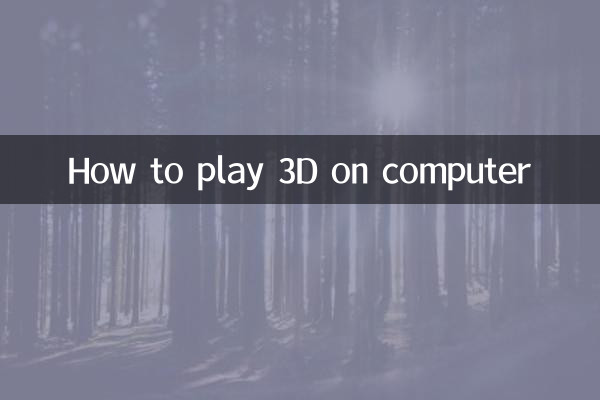How to display 3D on your computer: Explore hot topics and practical guides in the past 10 days
In today's digital era, 3D technology has become one of the hot topics. Whether it is entertainment, education or work, 3D content can bring a more immersive experience. This article will combine the hot spots across the Internet in the past 10 days to give you a detailed introduction to how to play 3D content on your computer and provide structured data for reference.
1. Popular 3D related topics in the past 10 days

| hot topics | heat index | Main discussion content |
|---|---|---|
| 3D movie playback skills | 85 | How to watch 3D movies on your home computer |
| Combination of VR and 3D technology | 78 | 3D applications in virtual reality |
| 3D game settings optimization | 92 | Methods to improve computer 3D game performance |
| 3D modeling software recommendations | 75 | Comparison of mainstream 3D creation tools |
2. Basic requirements for computers to play 3D content
To successfully play 3D content on your computer, your device needs to meet the following basic conditions:
1.Hardware requirements: At least a graphics card that supports 3D display is required, and mid-to-high-end graphics cards from NVIDIA or AMD are recommended.
2.monitor: A monitor or projector that supports 3D display is required. There are two common types: active 3D and passive 3D.
3.Software support: Corresponding 3D playback software needs to be installed, such as PowerDVD, VLC, etc.
4.3D glasses: Equipped with corresponding 3D glasses according to the type of display technology.
3. Comparison of mainstream 3D playback methods
| Play method | Advantages | Disadvantages | Applicable scenarios |
|---|---|---|---|
| Red and blue 3D | Low cost and good compatibility | Color distortion, easy to fatigue | Getting started |
| Polarization 3D | High color fidelity | Requires special screen | home theater |
| Active Shutter 3D | High resolution | Glasses are expensive and have flicker | Gaming and professional applications |
| VR head display | Strong sense of immersion | High equipment cost | virtual reality experience |
4. Detailed operation steps
1.Check hardware compatibility: Confirm that your graphics card supports the 3D output function, which can be viewed through the graphics card control panel.
2.Choose the right playback software:
- PowerDVD: Professional Blu-ray 3D playback software
- VLC Media Player: free and open source, supports some 3D formats
- Stereoscopic Player: Professional 3D video player
3.Set 3D display mode: Select the correct 3D format (top and bottom, left and right, interlaced, etc.) in the playback software.
4.Adjust 3D effects: Adjust depth of field and convergence point according to personal comfort.
5. Frequently Asked Questions
Q: Why is there ghosting in my 3D screen?
A: It may be that the 3D format setting is incorrect. Try switching to a different 3D display mode.
Q: What should I do if my eyes get tired easily when watching 3D content?
A: It is recommended to take a break every 30 minutes and adjust the 3D intensity to a comfortable level.
Q: Can I watch 3D on a normal monitor?
A: It can be simulated through software such as Red and Blue 3D, but the effect is limited.
6. Future development trends
According to recent technology hotspots, 3D display technology is developing in the following directions:
1.Naked-eye 3D technology: Eliminate dependence on special glasses
2.light field display: Provides a more realistic sense of depth
3.AI enhanced 3D: Optimized 3D content generation through artificial intelligence
Mastering how to play 3D content on your computer will allow you to fully enjoy the stunning experience brought by three-dimensional vision. With the development of technology, the acquisition and playback of 3D content will become more convenient, and we look forward to the emergence of more innovative applications.

check the details

check the details